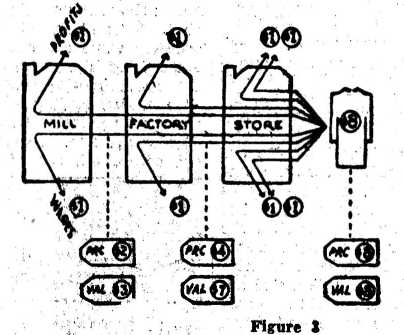
Main NI Index | Main Newspaper Index
Encyclopedia of Trotskyism | Marxists’ Internet Archive
From The Militant, Vol. X No. 36, 7 September 1946, p. 6.
Transcribed & marked up by Einde O’Callaghan for ETOL.
We continue with the flow chart of commodities and money in a capitalist system. Last week’s installment explained the various parts of the flow chart, Figure 3, which is repeated here?
The charted commodity, the coat, is finally sold for $8. The eight lines trace the money from it, back through the process, until it all ends up as income in the hands of workers or owners.
The total income in the hands of workers and owners is $8. That’s the same as the final sales price of the coat. It has to be, because it came from the sale of the coat. It also is exactly enough to buy the coat.
Considering the coat as the total output of all commodities, this means that all the buyers, owners and workers taken together, have exactly enough income to take to the market and buy all the goods there. There is no surplus or shortage of money; there is no surplus or shortage of goods. “Production equals income,” because income comes from production. No matter how complex we made the diagram, that would always hold true.
We can picture certain economic events with this chart. We’ll begin with the employers’ claim that high wages are the cause of high prices and shortages of goods. They say high wages have given the workers too much money, so they have bought up all the goods, leading to shortages and high prices. Even some labor leaders have been willing to echo this, and thus to discourage a fight for higher wages. Is there any truth in it?

|
In Figure 3, suppose the workers in the Factory got a raise, so their wages went up to $1.50, leaving only 50 cents instead of a dollar for the owners. The total buying power in the system would not be changed; it would still be $8, The factory could not take advantage of a scarcity to raise prices, and thus pass the wage raise on to the consumer, for there would be no scarcity of goods, arid no surplus of money.
Karl Marx summed up in Value, Price and Profit the result of an increases in wages of workers. He pointed but:
“... that an increase of their purchasing power must exactly correspond to the decrease of the purchasing power of the capitalists. The aggregate demand for commodities, would therefore not increase, but the constituent parts of that demand would change. The increasing demand on the one side would be counterbalanced by the decreasing demand on the other.”
Marx described how sales and production would follow the shift in demand. Increased demand from the workers’ side would cause more production of things the workers buy, more food, more low-priced clothing, more low-priced housing, etc. At the same time the decreasing demand from the profit! side would cause less production of things the owners buy. The shrinking market for high priced items and luxuries would tend to discourage production in those lines.
Today we see evidence in every retail store that the real situation is just the opposite. Producers and sellers are making every effort to offer only high priced items and luxuries, and are shifting away from the working class market. This shift is proof that the high demand comes from the profit side of the market, and not from the wage side.
Thus the evidence shows the opposite of the employers’ charge that high wages have caused high prices. Fabulous profits are boosting prices, not high wages.
This does not cover the present demand situation in full, because there is another feature we must lay over until we take up the topic of inflation.
Main Militant Index | Main Newspaper Index
Encyclopedia of Trotskyism | Marxists’ Internet Archive
Last updated on 27 June 2021